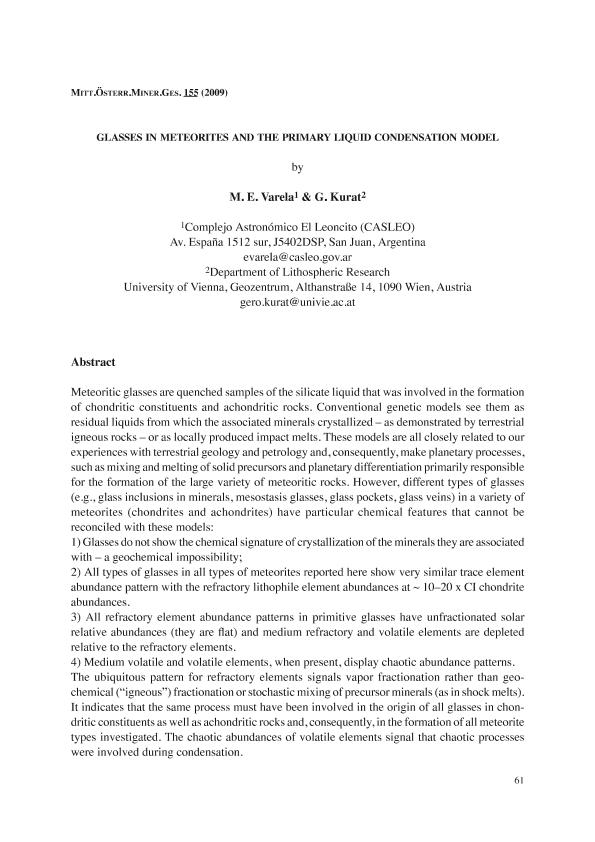Mostrar el registro sencillo del ítem
dc.contributor.author
Varela, Maria Eugenia

dc.contributor.author
Kurat, G.
dc.date.available
2023-10-11T10:51:48Z
dc.date.issued
2009-06
dc.identifier.citation
Varela, Maria Eugenia; Kurat, G.; Glasses in meteorites and the Primary Liquid Condensation Model; Österreichischen Mineralogischen Gesellschaft; Mitteilugen Der Osterreischischen Mineralogischen Gessellschaft; 155; 6-2009; 279-320
dc.identifier.issn
1680-8959
dc.identifier.uri
http://hdl.handle.net/11336/214770
dc.description.abstract
Meteoritic glasses are quenched samples of the silicate liquid that was involved in the formation of chondritic constituents and achondritic rocks. Conventional genetic models see them as residual liquids from which the associated minerals crystallized – as demonstrated by terrestrial igneous rocks – or as locally produced impact melts. These models are all closely related to our experiences with terrestrial geology and petrology and, consequently,make planetary processes, such asmixing andmelting of solid precursors and planetary differentiation primarily responsible for the formation of the large variety of meteoritic rocks. However, different types of glasses (e.g., glass inclusions in minerals, mesostasis glasses, glass pockets, glass veins) in a variety of meteorites (chondrites and achondrites) have particular chemical features that cannot be reconciled with these models: 1)Glasses do not showthe chemical signature of crystallization of theminerals they are associated with – a geochemical impossibility; 2) All types of glasses in all types of meteorites reported here show very similar trace element abundance pattern with the refractory lithophile element abundances at ~ 10–20 x CI chondrite abundances. 3) All refractory element abundance patterns in primitive glasses have unfractionated solar relative abundances (they are flat) and medium refractory and volatile elements are depleted relative to the refractory elements. 4) Medium volatile and volatile elements, when present, display chaotic abundance patterns. The ubiquitous pattern for refractory elements signals vapor fractionation rather than geochemical (“igneous”) fractionation or stochasticmixing of precursorminerals (as in shockmelts). It indicates that the same process must have been involved in the origin of all glasses in chondritic constituents aswell as achondritic rocks and, consequently, in the formation of allmeteorite types investigated. The chaotic abundances of volatile elements signal that chaotic processes were involved during condensation. 279 Herewe present a newmodel - the Primary Liquid Condensation (PLC)model – as an alternative to the currently acceptedmodels for the formation ofmeteoritic rocks. The PLCmodel is capable of accommodating all observational and chemical data accumulated so far on meteorites – with the exception of enstatite and SNC meteorites, which record physico-chemical conditions that were different fromthose of themajority ofmeteoritic rocks (the processes, however, could have been the same). The new model identifies a new role for silicate liquids in cosmochemistry as being an essential phase for the formation of early crystalline condensates from the hot solar nebula. Liquids are identified to have been the first major phase to condense from the solar nebula. In order to be capable to produce early liquid condensates, the nebula must have been either enriched in condensable elements over solar abundances (> 500 times) or was at total pressuresmuch higher than the canonically predicted ones (> 500 times, > 0.5 bar ). Our data require that this liquid – we named it “universal liquid” (UL) - had a refractory composition (Ca-Mg-Al-silicate or CMAS) and facilitated condensation of the major minerals for chondritic constituents as well as for achondritic rocks. The process possibly was a variant of the vapor-liquid-solid (VLS) condensation process, which is utilized in industrial crystal growth. Thereby, the liquid condenses first, then nucleates a crystal of the species that is oversaturated in the vapor – in the case of the solar nebula usually olivine. As this olivine grows from the liquid, it depletes the liquid in Mg and Si. The liquid tries to maintain equilibrium with the solar nebula. Thereby, Mg and Si are replenished by condensation from the gas phase and all incompatible elements are kept at an equilibrium concentration by condensation-evaporation equilibrium. Thus, the contents of incompatible refractory elements are kept at an approximately constant level throughout crystallization of the major minerals olivine and pyroxene. This way not only the abundances of incompatible refractory elements are kept at a constant level but also their relative abundances remain unfractionated solar. The UL also represents the long sought for refractory component of chondritic constituents and appears also to be the source of achondritic “igneous” rocks. Variations in the amount of liquid available, the liquid condensation and crystal nucleation rates, as well as different crystal-liquid mixing proportion will allow the formation of objects of highly variable composition. The final composition (chemical and isotopic) of any chondritic object or achondrite, as well as that of the associated glasses, will be determined by different degrees of post-formational metasomatic elemental exchange processes taking place between solids and the cooling nebular gas. These processes add medium volatile and volatile elements to the products of high temperature condensation. As these processes usually don’t run to completion, an infinite number of chaotic compositional variations are produced – and this is exactly what we observe in meteorites.
dc.format
application/pdf
dc.language.iso
eng
dc.publisher
Österreichischen Mineralogischen Gesellschaft
dc.rights
info:eu-repo/semantics/openAccess
dc.rights.uri
https://creativecommons.org/licenses/by-nc-sa/2.5/ar/
dc.subject
Liquids
dc.subject
first condensates
dc.subject
glasses
dc.subject
meteorites
dc.subject.classification
Otras Ciencias Naturales y Exactas

dc.subject.classification
Otras Ciencias Naturales y Exactas

dc.subject.classification
CIENCIAS NATURALES Y EXACTAS

dc.title
Glasses in meteorites and the Primary Liquid Condensation Model
dc.type
info:eu-repo/semantics/article
dc.type
info:ar-repo/semantics/artículo
dc.type
info:eu-repo/semantics/publishedVersion
dc.date.updated
2023-07-07T20:32:20Z
dc.journal.volume
155
dc.journal.pagination
279-320
dc.journal.pais
Austria

dc.journal.ciudad
Innsbruck
dc.description.fil
Fil: Varela, Maria Eugenia. Consejo Nacional de Investigaciones Científicas y Técnicas. Centro Científico Tecnológico Conicet - San Juan. Complejo Astronómico "El Leoncito". Universidad Nacional de Córdoba. Complejo Astronómico "El Leoncito". Universidad Nacional de la Plata. Complejo Astronómico "El Leoncito". Universidad Nacional de San Juan. Complejo Astronómico "El Leoncito"; Argentina
dc.description.fil
Fil: Kurat, G.. Vienna University of Technology; Austria
dc.journal.title
Mitteilugen Der Osterreischischen Mineralogischen Gessellschaft
dc.relation.alternativeid
info:eu-repo/semantics/altIdentifier/url/https://www.uibk.ac.at/mineralogie/oemg/bd_155/155_279-320.pdf
Archivos asociados
